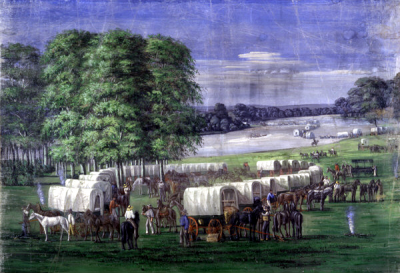The Oregon Trail was a 2,170-mile (3,490 km) eastwest, large-wheeled wagon route and emigrant trail in the United States that connected the Missouri River to valleys in Oregon. The eastern part of the Oregon Trail spanned part of what is now the state of Kansas and nearly all of what are now the states of Nebraska and Wyoming. The western half of the trail spanned most of the current states of Idaho and Oregon.
The Oregon Trail was laid by fur traders and trappers from about 1811 to 1840 and was only passable on foot or on horseback. By 1836, when the first migrant wagon train was organized in Independence, Missouri, a wagon trail had been cleared to Fort Hall, Idaho. Wagon trails were cleared increasingly farther west and eventually reached all the way to the Willamette Valley in Oregon, at which point what came to be called the Oregon Trail was complete, even as almost annual improvements were made in the form of bridges, cutoffs, ferries, and roads, which made the trip faster and safer. From various starting points in Iowa, Missouri, or Nebraska Territory, the routes converged along the lower Platte River Valley near Fort Kearny, Nebraska Territory, and led to rich farmlands west of the Rocky Mountains.
From the early to mid-1830s (and particularly through the years 18461869) the Oregon Trail and its many offshoots were used by about 400,000 settlers, farmers, miners, ranchers, and business owners and their families. The eastern half of the trail was also used by travelers on the California Trail (from 1843), Mormon Trail (from 1847), and Bozeman Trail (from 1863) before turning off to their separate destinations. Use of the trail declined after the first transcontinental railroad was completed in 1869, making the trip west substantially faster, cheaper, and safer. Today, modern highways, such as Interstate 80 and Interstate 84, follow parts of the same course westward and pass through towns originally established to serve those using the Oregon Trail.
A wagon train is a group of wagons traveling together. Before the extensive use of military vehicles, baggage trains followed an army with supplies and ammunition.
In the American West, settlers traveling across the plains and mountain passes in covered wagons banded together for mutual assistance. Although wagon trains are associated with the Old West, the Trekboers of South Africa also traveled in caravans of covered wagons.

1843May, 16
The first major wagon train heading for the Pacific Northwest sets out on the Oregon Trail with one thousand pioneers from Elm Grove, Missouri.
Choose Another Date
Events on 1843
- 11Feb
I Lombardi alla prima crociata
Giuseppe Verdi's opera I Lombardi alla prima crociata receives its first performance in Milan, Italy. - 16May
Oregon Trail
The first major wagon train heading for the Pacific Northwest sets out on the Oregon Trail with one thousand pioneers from Elm Grove, Missouri. - 17Jun
New Zealand Wars
The Wairau Affray, the first serious clash of arms between Māori and British settlers in the New Zealand Wars, takes place. - 19Jul
SS Great Britain
Brunel's steamship the SS Great Britain is launched, becoming the first ocean-going craft with an iron hull and screw propeller, becoming the largest vessel afloat in the world. - 21Sep
Strait of Magellan
John Williams Wilson takes possession of the Strait of Magellan on behalf of the newly independent Chilean government.

 English
English  español
español  français
français  português
português  русский
русский  العربية
العربية  简体中文
简体中文 